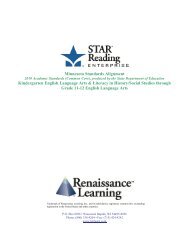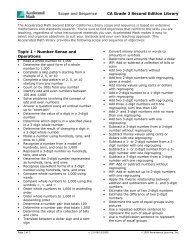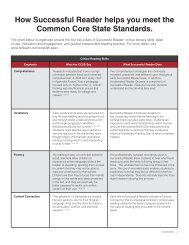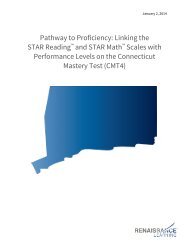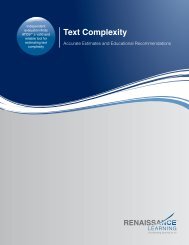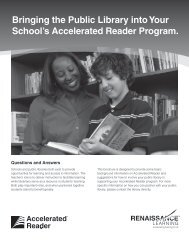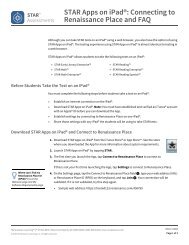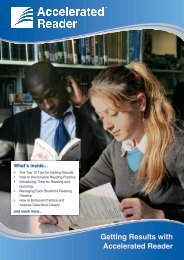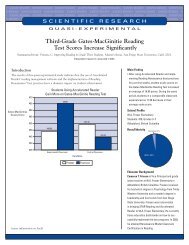Technical Manual - Renaissance Learning
Technical Manual - Renaissance Learning
Technical Manual - Renaissance Learning
You also want an ePaper? Increase the reach of your titles
YUMPU automatically turns print PDFs into web optimized ePapers that Google loves.
ValidityPost-Publication Study DataDIBELS, GRADE, and TPRIIn September and October, 2004, <strong>Renaissance</strong> <strong>Learning</strong> conducted a study of therelationships of STAR Early Literacy scores and scores on three widely used earlyliteracy assessments: DIBELS, 7 TPRI, 8 and GRADE. 9 These assessments werechosen for study because they measure most or all of the five critical skillsidentified in the 2000 report of the National Reading Panel: PhonologicalAwareness, Phonics, Vocabulary, Text Comprehension, and Fluency. Two of them,DIBELS and TPRI, are widely used for assessment within Reading First programs.Following is a short summary of the tests administered within each assessment.DIBELS—The following tests were administered at the grades indicated: Initialsound fluency (ISF), letter naming fluency (LNF), phoneme segmentation fluency(PSF), nonsense word fluency (NWF) and word usage fluency (WUF) wereadministered to kindergartners. First graders took letter naming fluency (LNF),phoneme segmentation fluency (PSF), nonsense word fluency (NWF), word usagefluency (WUF), oral reading fluency (ORF), and retell fluency (RF). Second graderstook just four assessments: nonsense word fluency (NWF), word usage fluency(WUF), oral reading fluency (ORF), and retell fluency (RF). At their discretion, someteachers omitted specific assessments.GRADE—Kindergarten students took Word Reading and 5 subtests measuringphonological awareness and some phonics skills. All students in grades 1 and 2took Word Reading, Word Meaning, Sentence Comprehension, and PassageComprehension. GRADE reports subtest raw scores, and composite standardscores and scale scores.TPRI—All students took one, two, or three short screening subtests: threescreening tests for kindergarten, two for grade 1, and one for grade 2. The screenerwas followed by short inventory tests (tasks) measuring specific phonemicawareness, graphophonemic knowledge, and fluency and/or comprehensionskills. In TPRI, the choice of inventory tests is made adaptively, using branchingrules followed by the teacher; not every student took all subtests, but all shouldhave taken the comprehension and/or fluency measures. A listeningcomprehension test is used at kindergarten. At grades 1 and 2, students read aleveled oral reading fluency passage, followed by a short reading comprehensiontest on the passage; the choice of the reading passage is based on the student’sperformance on a 15-item word reading task.7. Dynamic Indicators of Basic Early Literacy Skills (University of Oregon, Institute for Development ofEducational Achievement, 2002).8. Texas Primary Reading Inventory 2004–2006 (Texas Education Agency and the University of TexasSystem, 2003).9. Group Reading Assessment and Diagnostic Evaluation (American Guidance Service, Inc., 2001).STAR Early Literacy<strong>Technical</strong> <strong>Manual</strong>69





